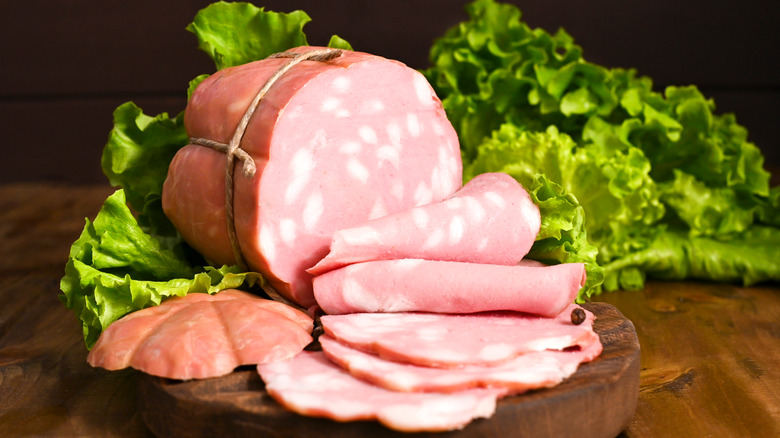Mortadella Vs. Bologna: What's The Difference?
Bologna is America's signature pink deli meat, and while it often gets a bad rap, the cold cut is surprisingly versatile — not to mention cross-cultural. Fly to Europe or head to your nearest Italian food store to taste Italy's more refined take on bologna. Granted, Italy is more closely associated with prosciutto, bresaola, and salami than it is with bologna. However, try one bite of mortadella, and you'll realize that the Italian original is quite different from the bologna sandwiches of your middle school days.
Per MasterClass, mortadella is relatively similar in taste and texture to the American cold cut and can be enjoyed in similar ways. Use a few slices for a simple sandwich, or roll a piece to eat plain. But once you pair mortadella and focaccia for a picnic lunch, you'll realize that the similarities end there. Thinly-sliced mortadella is a far cry from thick slabs of bologna — and you certainly don't need potato chips and mustard to dress up your meal. These meats may be lunch lookalikes, but they deviate in how they're made.
Mortadella is the original, more flavorful bologna
Mortadella is bologna-adjacent but with deeper roots than the American cold cut. According to Insider, mortadella originated in Bologna, Italy, during the Renaissance. The meat is so popular abroad that Italy makes more than 3 billion pounds of mortadella annually.
The process of making mortadella is similar to sausage-making, mainly because mortadella is, technically, a take on sausage. Per MasterClass, mortadella consists of heat-cured pork and fat cubes minced into a paste via a grinder. Once seasoned with peppercorns, pistachios, and other flavorings, mortadella is fit in a sausage casing. It is then slow-cooked for roughly a day. Premium mortadella from Bologna keeps fillers and preservatives to a minimum and is a cured meat with complex flavor (via the Slow Food Foundation for Biodiversity).
Once the mortadella is ready, you can use it in many ways. Sandwiches are popular options, although you can incorporate mortadella into your next bolognese. Or, consider adding a few slices atop a homemade pizza. The best mortadella is thinly-cut, per Food52, so the meat doesn't weigh down your pizza.
Bologna is a simplified spin-off of mortadella
Bologna or baloney — no matter how you spell it — is not synonymous with mortadella. Like its predecessor, bologna is essentially an emulsified sausage (via Serious Eats). Both meats take the sausage-making process a step further than simply grinding the meat and are formed by creating a meat paste that yields a uniform look.
The difference in texture is what distinguishes bologna from mortadella. As mentioned, mortadella consists of fat cubes or "lardelli" and pistachios that break up the meat, whereas bologna is entirely uniform in texture, taste, and appearance (via Taste Atlas). Further, according to Boar's Head, bologna can consist of both pork and beef, whereas mortadella is just pork.
According to Mental Floss, makers of bologna do use spices, but they don't attempt to incorporate whole ingredients. Also, more preservatives tend to be added to bologna, making it a processed, less artisan product than mortadella (via Huffpost). Because of this, Food52 calls the two types of meat "distant relatives," noting that the process of making mortadella yields a more complex flavor and texture. You can easily taste this difference; bologna has a less refined flavor than mortadella, and because it's often more thickly cut, it is not as delicate as its sophisticated predecessor. But don't count bologna out just yet. Where bologna shines is not as a cold cut but as a warm meal. Southern Living recommends this tasty fried bologna sandwich, which, as a quick meals go, is quite a treat.


